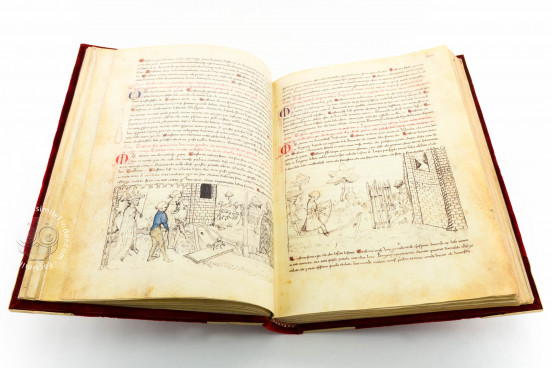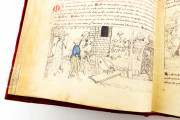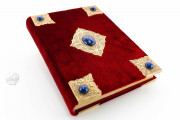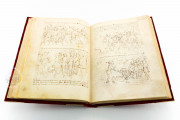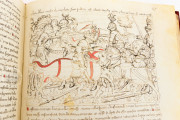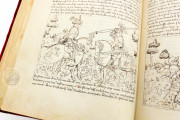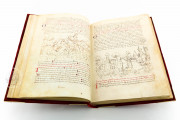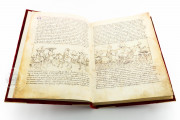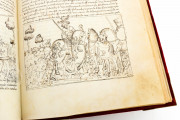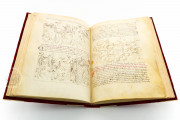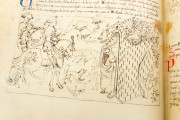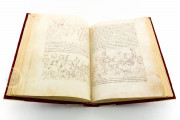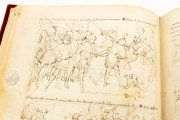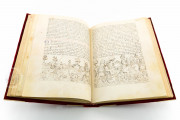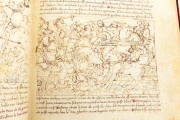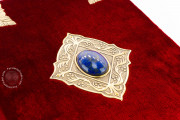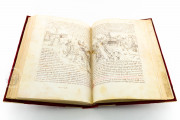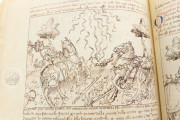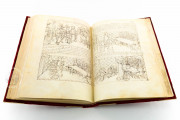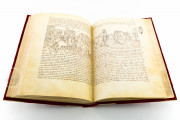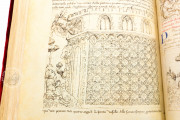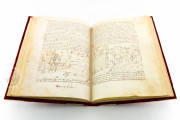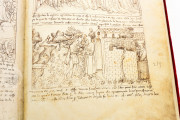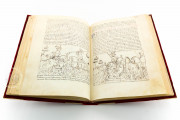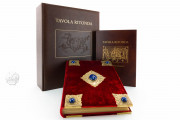The Round Table in Florence is the only surviving illuminated manuscript of the collection of Arthurian tales in Italian known as the Tavola Rotonda. One of its scribes, Zuliano di Anzoli, dated the completion of the writing to July 20, 1446. He, his fellow scribes, and the book's illuminators from the workshop of Bonifacio Bembo created the manuscript in northern Italy, perhaps in Cremona. The stories of Lancelot, Tristan, and other knights of the round table are depicted in 289 images executed entirely in high-quality line drawings in brown ink.
The narrative scenes in the Round Table extend the entire width of the writing area on the page. All are in landscape format (wider than tall), and one—the treating of Tristan's wound (at the bottom of fol. 18v)—is very narrow. Unusually, the miniature of Perceval's Encounter with the Devil zig-zags in a diagonal across the page, lending drama to the representation of the devil-horse plunging into the water (fol. 140v).
An Unusual Technique
The Italian text of the Tavola Rotonda was assembled in the early fourteenth century from the French prose Arthurian tales of the thirteenth century. The illumination of the Italian manuscript, however, is utterly different from the colorful column miniatures of the manuscripts of the French Arthurian romances.
The drawings of the Round Table are almost entirely without color, and they often feature finely detailed repeating patterns as backgrounds. The figures are stocky and dwarf their architectural and landscape settings. They also depart from the French tradition in the choice of episodes depicted.
Battles and Pageantry Depicted
The manuscript teams with images of battle, both hand-to-hand combat (such as Tristan Fighting, fol. 57r) and mounted encounters (such as Palamides Struck Down, fol. 83v). The artists lavished great attention not only on the human combatants but also on their horses. There are many representations of wild animals, including leopards and lions. Court ceremony is rendered in sumptuous detail, such as in the miniature of the Departure of Isolde for the Tournament (fol. 88v).
Focus on Lancelot and Tristan
The manuscript was written in long lines (one column per page) in Gothic Hybrida by at least three scribes, Zuliano di Anzoli and at least two others. Zuliano wrote the rubrics—long headings in red ink that encapsulate the following narrative. Each section of the text is introduced by a pen-flourished initial, generally alternating red with blue flourishing and blue with red flourishing.
The stories of the Tavola Rotonda begin and end with sections devoted to Lancelot and Tristan, which bracket the long narrative of the quest—undertaken by knights of the legendary King Arthur's round table—for the holy grail, a vessel associated with Christ. Although the protagonists of the grail pursuit—Galahad, Perceval, and Bors—dominate the text, the scribe of the early part of the manuscript has emphasized Lancelot and Tristan by adding touches of color at each appearance of their names, yellow on the L of Lanziloto and red on the T of Tristano.
Possible Patrons
Although we do not know for whom the Round Table manuscript was made, it may have been intended for the delight and edification of someone within the courtly circles of Lombardy or Emilia, perhaps a prince of the region. Francesco Sforza (1401-1466), Duke of Milan, and his consort, Bianca Maria Visconti (1425-1468)—known to have patronized the Bembos—have been suggested, as has Pier Maria Rossi (1413-1482), who served Francesco as a mercenary captain in campaigns against Venice. The manuscript has been in the collection of Florence's Biblioteca Nazionale Centrale since at least the beginning of the twentieth century.
We have 1 facsimile edition of the manuscript "Round Table": Tavola Ritonda facsimile edition, published by Istituto dell'Enciclopedia Italiana - Treccani, 2009
Request Info / Price
